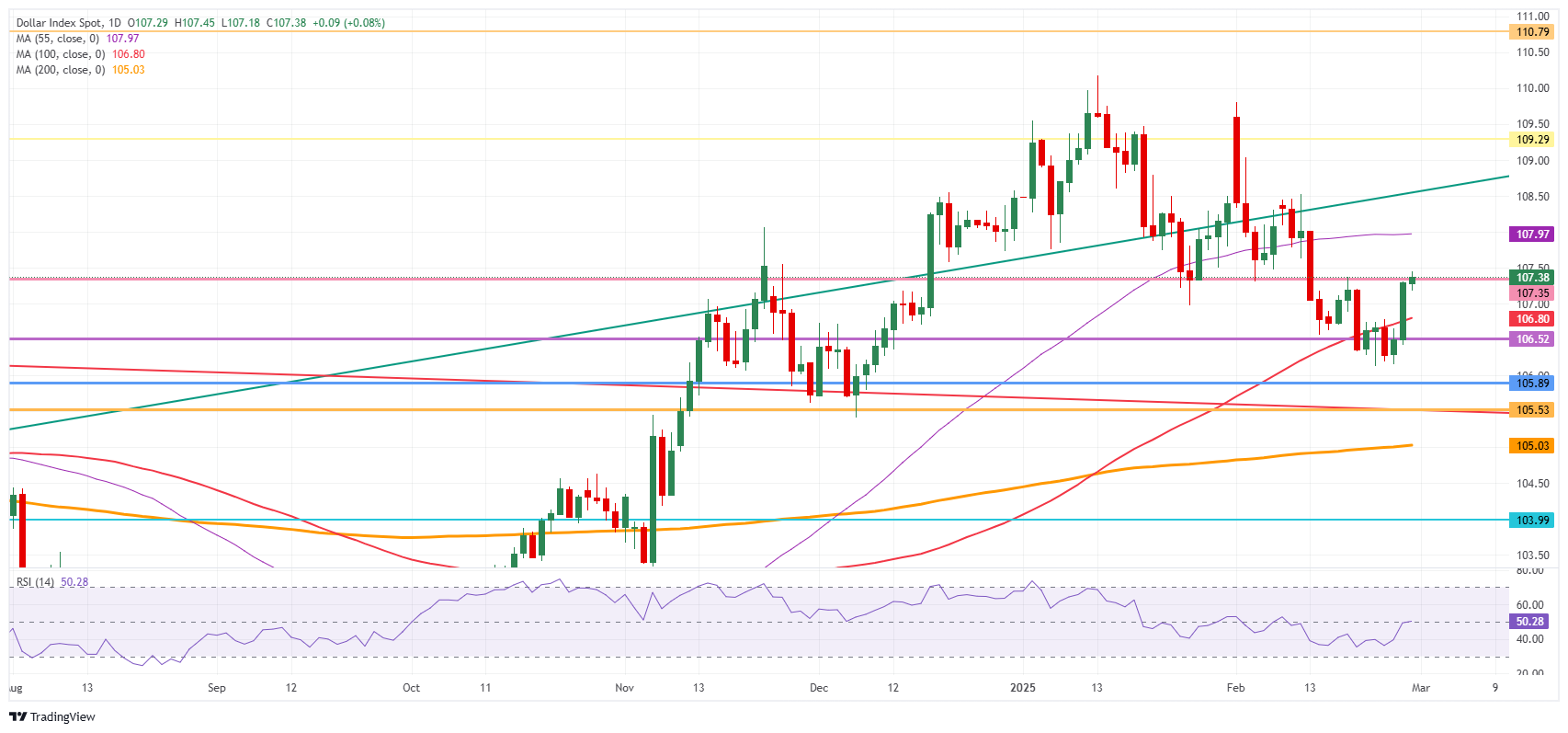US Dollar holds steady while President Zelenskyy heads to the White House
- The US Dollar holds steady on Friday ahead of the US PCE reading for January.
- Traders expect a stronger PCE after the uptick in PCE under the quarterly GDP release on Thursday.
- The US Dollar Index (DXY) tries to consolidate gains above 107.00.
The US Dollar Index (DXY), which tracks the performance of the US Dollar (USD) against six major currencies, trades around 107.40 at the time of writing on Friday and tries to keep a hold on that level. Markets got shaken up again overnight as United States (US) President Donald Trump confirmed that tariffs for Canada and Mexico are going into effect on March 4. Meanwhile, China will face an additional 10% levy on the same day.
On the economic data front, all eyes on Friday are on the Personal Consumption Expenditures (PCE) data for January. In the second reading of the US Gross Domestic Product (GBP) for the fourth quarter of 2024 on Thursday, the PCE components for both the headline and the core reading were revised up. This tweaks traders’ anticipation at the last minute to possibly see a surprise uptick in the Federal Reserve’s (Fed) preferred inflation gauge.
Daily digest market movers: Inflation and tariffs
- Ukraine President Volodymyr Zelenskyy is heading to Washington D.C. to sign a rare-earth deal with US President Donald Trump this Friday.
- At 13:30 GMT, the Personal Consumption Expenditures Price Index for January is due:
- The monthly headline PCE is expected to come in at 0.3%, unchanged from the previous reading.
- The monthly core PCE reading is expected to tick up to 0.3% from 0.2% in December.
- The headline PCE is expected to rise 2.5% year-over-year compared to 2.6% in December, while the core PCE is expected to rise 2.6% in January compared to 2.8% in the previous month.
- At 14:45 GMT, the Chicago Purchase Managers Index for February is due. The expectation is still for a contraction at 40.6, coming from 39.5 in January.
- Equities are very split this Friday, with heavy losses in Asian trading, while Europe sees mild losses, and US futures are ready for a positive tone just hours before the US opening bell.
- The CME Fedwatch Tool projects a 29.7% chance that interest rates will remain at the current range of 4.25%-4.50% in June, with the rest showing a possible rate cut.
- The US 10-year yield trades around 4.25%, further down from last week’s high at 4.574%.
US Dollar Index Technical Analysis: 107.00 holds
Finally, the US Dollar Index (DXY) might have had a nice uptick. Holding current ground will be key, with the biggest challenge coming from US yields still trending lower, narrowing the rate differential between the US and other countries. Another leg lower is possible should inflation concerns swirl back and push US yields higher again, supporting a stronger US Dollar.
On the upside, the 55-day Simple Moving Average (SMA) is the first resistance to watch for any rejections, currently at 107.97. In case the DXY can break above the 108.00 round level, 108.50 is coming back in scope.
On the downside, as already mentioned, 107.00 needs to hold as support. Nearby, 106.80 (100-day SMA) and 106.52, as a pivotal level, should act as support and avoid any returns to the lower 106-region.

US Dollar Index: Daily Chart
US Dollar FAQs
The US Dollar (USD) is the official currency of the United States of America, and the ‘de facto’ currency of a significant number of other countries where it is found in circulation alongside local notes. It is the most heavily traded currency in the world, accounting for over 88% of all global foreign exchange turnover, or an average of $6.6 trillion in transactions per day, according to data from 2022. Following the second world war, the USD took over from the British Pound as the world’s reserve currency. For most of its history, the US Dollar was backed by Gold, until the Bretton Woods Agreement in 1971 when the Gold Standard went away.
The most important single factor impacting on the value of the US Dollar is monetary policy, which is shaped by the Federal Reserve (Fed). The Fed has two mandates: to achieve price stability (control inflation) and foster full employment. Its primary tool to achieve these two goals is by adjusting interest rates. When prices are rising too quickly and inflation is above the Fed’s 2% target, the Fed will raise rates, which helps the USD value. When inflation falls below 2% or the Unemployment Rate is too high, the Fed may lower interest rates, which weighs on the Greenback.
In extreme situations, the Federal Reserve can also print more Dollars and enact quantitative easing (QE). QE is the process by which the Fed substantially increases the flow of credit in a stuck financial system. It is a non-standard policy measure used when credit has dried up because banks will not lend to each other (out of the fear of counterparty default). It is a last resort when simply lowering interest rates is unlikely to achieve the necessary result. It was the Fed’s weapon of choice to combat the credit crunch that occurred during the Great Financial Crisis in 2008. It involves the Fed printing more Dollars and using them to buy US government bonds predominantly from financial institutions. QE usually leads to a weaker US Dollar.
Quantitative tightening (QT) is the reverse process whereby the Federal Reserve stops buying bonds from financial institutions and does not reinvest the principal from the bonds it holds maturing in new purchases. It is usually positive for the US Dollar.


